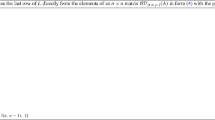Abstract
Let \(A \in {\mathbb {R}}^{n \times n}\) be a totally nonpositive matrix (t.n.p.) with rank r and principal rank p, that is, every minor of A is nonpositive and p is the size of the largest invertible principal submatrix of A. We introduce that a triple (n, r, p) will be called negatively realizable if there exists a t.n.p. matrix A of order n and such that its rank is r and its principal rank is p. In this work we extend the results obtained for irreducible totally nonnegative matrices given in Cantó and Urbano (Linear Algebra Appl 551:125–146. https://doi.org/10.1016/j.laa.2018.03.045, 2018) to t.n.p. matrices. For that, we consider the sequence of the first p-indices of A and study the linear dependence relations between their rows and columns. These relations allow us to construct t.n.p. matrices associated with a triple (n, r, p) negatively realizable and a specific sequence of the first p-indices.
Similar content being viewed by others
References
Ando, T.: Totally positive matrices. Linear Algebra Appl. 90, 165–219 (1987). https://doi.org/10.1016/0024-3795(87)90313-2
Bapat, R.B., Raghavan, T.E.S.: Nonnegative Matrices and Applications. Cambridge University Press, New York (1997)
Bhatia, R.: Positive Definite Matrices, Princeton Ser. Appl. Math. (2007)
Cantó, R., Urbano, A.M.: On the maximum rank of totally nonnegative matrices. Linear Algebra Appl. 551, 125–146 (2018). https://doi.org/10.1016/j.laa.2018.03.045
Cantó, R., Koev, P., Ricarte, B., Urbano, A.M.: LDU-factorization of nonsingular totally nonpositive matrices. SIAM J. Matrix Anal. Appl. 30, 777–782 (2008). https://doi.org/10.1137/060662897
Cantó, R., Ricarte, B., Urbano, A.M.: Full rank factorization in echelon form of totally nonpositive (negative) rectangular matrices. Linear Algebra Appl. 431, 2213–2227 (2009). https://doi.org/10.1016/j.laa.2009.07.020
Cantó, R., Ricarte, B., Urbano, A.M.: Quasi-\(LDU\) factorization of nonsingular totally nonpositive matrices. Linear Algebra Appl. 439, 836–851 (2013). https://doi.org/10.1016/j.laa.2012.06.010
Cantó, R., Ricarte, B., Urbano, A.M.: Full rank factorization in quasi-\(LDU\) form of totally nonpositive rectangular matrices. Linear Algebra Appl. 440, 61–82 (2014). https://doi.org/10.1016/j.laa.2013.11.002
Cantó, R., Peláez, M.J., Urbano, A.M.: On the characterization of totally nonpositive matrices. SeMA J. 73, 347–368 (2016). https://doi.org/10.1007/s40324-016-0073-1
Fallat, S.M., van den Driessche, P.: On Matrices with all minors negative. Electron. J. Linear Algebra 7, 92–99 (2000). http://math.technion.ac.il/iic/ela
Fallat, S.M., Gekhtman, M.I.: Jordan structure of totally nonnegative matrices. Can. J. Math. 57, 82–98 (2005). https://doi.org/10.4153/CJM-2005-004-0
Fallat, S.M, Johnson, C.R.: Totally Nonnegative Matrices. Princeton Ser. Appl. Math. (2011)
Fallat, S.M., Gekhtman, M.I., Johnson, C.R.: Spectral structures of irreducible totally nonnegative matrices. SIAM J. Matrix Anal. Appl. 22, 627–645 (2000). https://doi.org/10.1137/S0895479800367014
Gasca, M., Micchelli, C.A.: Total Positivity and Applications. Math. Appl., 359, Kluwer Academic Publishers, Dordrecht (1996)
Huang, R., Chu, D.: Total nonpositivity of nonsingular matrices. Linear Algebra Appl. 432, 2931–2941 (2010). https://doi.org/10.1016/j.laa.2009.12.043
Karlin, S.: Total Nonpositivity, vol. I. Stanford University Press, Stanford (1968)
Parthasarathy, T., Ravindran, G.: N-matrices. Linear Algebra Appl. 139, 89–102 (1990). https://doi.org/10.1016/0024-3795(90)90390-X
Pinkus, A.: Totally Positive Matrices. Cambridge University Press, New York (2010)
Saigal, R.: On the class of complementary cones and Lemke’s algorithm. SIAM J. Appl. Math. 23, 46–60 (1972). https://www.jstor.org/stable/2099622
Author information
Authors and Affiliations
Corresponding author
Additional information
Publisher's Note
Springer Nature remains neutral with regard to jurisdictional claims in published maps and institutional affiliations.
This research was supported by the Ministerio de Economía y Competividad under the Spanish DGI Grant MTM2017-85669-P-AR.
Appendix
Appendix
In this section, we construct Algorithm 2 associated with Procedure 1 to obtain an upper block echelon TN matrix \(V\in {\mathbb {R}}^{n \times n}\) with \(\mathop {\mathrm{rank}}\nolimits (V)=r\), \(p\)-\(\mathop {\mathrm{rank}}\nolimits (V)=p\) and the sequence of its first p-indices given by \(\{ 1,i_2,\ldots ,i_p \}\). To apply Algorithm 2 we introduce Algorithm 1 given in [4, Algorithm 1] in order to know the maximum rank of a matrix depending on the sequence of its first p-indices.


Finally, we consider a triple \((n,r,p) (1,i_2,\ldots ,i_p)\)-negatively realizable of the type-I (type-II), and we construct Algorithm 3 (Algorithm 4) to obtain a type-I (type-II) t.n.p. matrix A associated with the given triple. These algorithms are based on Procedure 2.


As we have seen in the proof of Proposition 8 to obtain a t.n.p. matrix by Procedure 2 we only need that \(\, d_{1} \ge \sum _{j=2}^{i_p} v_{jn}\). As a consequence, from Algorithms 3 and 4, we can obtain different type-I and type-II t.n.p. matrices associated with the given triple by changing the value of D(1, 1) and whenever \(D(1,1) \le -t*V(:,n)\).
Rights and permissions
About this article
Cite this article
Cantó, B., Cantó, R. & Urbano, A.M. On totally nonpositive matrices associated with a triple negatively realizable. RACSAM 115, 134 (2021). https://doi.org/10.1007/s13398-021-01073-9
Received:
Accepted:
Published:
DOI: https://doi.org/10.1007/s13398-021-01073-9




